

R Y |
H2, Pd |
R H + H Y |
III.3 Palladium-Catalyzed
Carbon–Hydrogen and
Carbon–Heteroatom Coupling
III.3.1 Palladium-Catalyzed Hydrogenolysis
ANTHONY O. KING and ROBERT D. LARSEN
A. INTRODUCTION
Palladium catalysts are the most widely used catalysts for the hydrogenolysis of organic substrates. Pt and Raney nickel catalysts are also effective for hydrogenolysis in many cases but are used much less frequently than palladium. As shown below in this section, palladium catalysts can catalyze effectively the hydrogenolysis of a wide variety of functional groups. Carbon–carbon, carbon–halogen, carbon–nitrogen, carbon–oxygen, nitrogen–nitrogen, nitrogen–oxygen, and oxygen–oxygen bonds can all be hydrogenolyzed readily under palladium catalysis. The reaction conditions are generally mild and by choosing the appropriate catalysts and reaction conditions, many other functional groups in the substrate can be tolerated. The following presents a summary of Pd-catalyzed hydrogenolysis reactions that have been reported in the literature.
B. HYDROGENOLYSIS OF CYCLOPROPANE
The hydrogenolysis of cyclopropyl derivatives is a convenient method for the introduction of a methyl or methylene group into the substrate. The location of the C—C bond cleavage on the cyclopropyl ring system can be predicted in many cases by the substitution pattern on the ring and the 3-D structure of the substrate.
Hydrogenolysis of tricyclic ketone 1 provided selectively [4.3.0] bicyclic ketone 2
(Scheme 1).[1]
The release of the four-membered ring strain is probably the driving force for this regioselective ring opening. In an analogous system, but with even less steric congestion because of the absence of the dimethyl substituents, bicyclo[2.1.0]amino acid 3 still preferably opened at the more substituted C—C bond to give pyrrolidine product 4
(Scheme 2).[2]
Handbook of Organopalladium Chemistry for Organic Synthesis, Edited by Ei-ichi Negishi ISBN 0-471-31506-0 © 2002 John Wiley & Sons, Inc.
995

996 III Pd-CATALYZED CROSS-COUPLING |
|
|
|
|
||||||||
O |
|
|
|
1 atm H2 |
O |
|
||||||
|
|
|
H |
H |
|
|
24 wt % of |
|
|
|
H |
|
|
|
|
|
|
|
|
||||||
|
|
|
|
|
|
|
Pd/C(10%) |
|
|
|
|
|
|
|
|
|
|
|
|
EtOH |
|
|
|
|
|
|
|
|
|
|
|
|
20 °C, 48 h |
|
|
|
|
|
|
|
|
H |
H |
|
|
|
|
|
|
|
H |
1 |
|
|
|
|
|
2 |
96% |
|||||
|
|
|
|
|
|
|
Scheme 1 |
|
|
|
|
|
|
|
|
|
|
|
|
1 atm H2 |
|
|
|
|
|
|
|
|
|
|
|
|
20 wt % of |
|
|
|
|
|
|
|
|
|
|
|
|
Pd/C |
|
|
|
|
|
|
|
|
|
|
|
|
water, |
|
|
|
CO2H |
|
HN |
|
CO2H |
|
r.t., 3 h |
|
|
|
|||||
H |
|
|
|
NH |
H |
|||||||
|
|
|
|
|
|
|
|
|||||
3 |
|
|
|
|
|
4 |
|
|
|
|||
Scheme 2
Hydrogenolysis of 1,1-dichloro-substituted cyclopropane 5 using 3% Pd/C catalyst proceeded at the C—C bond directly opposite the chloro-substituted carbon to give 1,3- diarylpropane 6 (Scheme 3).[3] Lindlar’s catalyst was not effective. Dropping the Pd on carbon loading from 3% to 1% gave only dechlorination without ring opening. Therefore, the dechlorination reaction most likely proceeded first before the ring cleavage with the 3% Pd/C catalyst. Although the hydrogenolyzed C—C bond was more hindered, the electronic activation provided by the presence of the two aryl substituents may have overcome the steric factor.
Cl
Cl |
|
|
|
OH |
||
|
|
|
|
|||
|
|
H |
2.7 atm H2 |
|
|
|
|
|
|
|
|||
|
|
|
|
|||
|
|
|
|
|||
|
|
|
||||
|
|
|
Pd/C (3%) |
|||
|
|
|
EtOH |
|||
|
|
|
r.t., 1.5 h |
|
||
O
H
5 |
6 |
Scheme 3
Bicyclo[3.1.0]phosphine oxide 7 also gave a diastereomeric mixture of the sixmembered phosphine oxide 11 in 70% yield and not the five-membered ring product (Scheme 4).[4] The hydrogenolysis proceeded through the mixture of dihydrophosphinines.
Similarly, 1,1-difluorinated cyclopropanes 12 and 16 reacted via the cleavage of the C—C bond directly opposite the difluoro-substituted carbon (Scheme 5).[5]

Cl |
Cl |
H |
|
Ph |
P |
O |
|
|
7 |
|
III.3.1 |
Pd-CATALYZED HYDROGENOLYSIS |
997 |
9 atm H2 |
|
|
|
60 wt % of |
|
|
|
Pd/C (10%) |
|
|
|
MeOH, Et3N |
|
|
|
20−90 °C |
|
P |
|
10 h |
|
|
|
Ph |
O |
|
|
|
|
||
11 70% (80:20 mixture)
H |
Cl |
|
|
|
|
|
|
H |
|
|
|
|
+ |
|
|
|
|
|
|
|
|
||
P |
|
|
|
P |
P |
||
|
|
Ph |
Ph |
||||
O |
|
O |
|
O |
|||
Ph |
|
|
9 |
|
10 |
|
|
8 |
|
|
|
|
|
||
|
|
Scheme 4 |
|
|
|
|
|
F F
12
F
F
16
25 atm H2
75 wt % of Pd/C (10%)
pentane r.t., 0.5 h
|
|
|
+ |
|
|
+ |
|
|
|
|
|
|
|
|
|
F |
|
F |
|
F |
|
|
|
|
|
|
|
|
15 |
3% |
|
|
13 |
61% |
|
14 |
35% |
||
|
|
+ |
|
+ |
|
|
|
F |
|
F |
F |
|
|
|
|
|
|
|
|
|
|
||
|
|
|
|
19 |
8% |
|
|
17 |
57% |
18 |
31% |
|
|||
Scheme 5
In fact, gem-difluorocyclopropanes undergo hydrogenolysis much faster than monofluorocyclopropanes. Although hydrogenolysis of the C—F bond is usually very difficult, in these instances, loss of one or both of the fluorine atoms was also observed.
Cyclopropanation of an olefin followed by hydrogenolysis of the resulting cyclopropane is an effective method for the introduction of a methyl group onto a substrate. A geminal dimethyl group can be prepared readily in this fashion. However, Pt is a more effective catalyst as shown in these examples. Thus, spiro compounds 20 and 22 were hydrogenolyzed to dimethyl derivatives 21 and 23, respectively (Scheme 6).[6],[7]
Although steric factors may have influenced the regioselective ring opening in 24, which produced the symmetrical ketone 25 quantitatively, the carbonyl group also directed the cleavage of the C—C bond (Scheme 7).[8]
The geminal bis-(ethoxycarbonyl)-substituted cyclopropane 26 effectively countered the steric problem to give cleavage at the more highly substituted C—C bond (Scheme 8).[9] The nitrogen atom may also have assisted in directing this C—C bond cleavage.
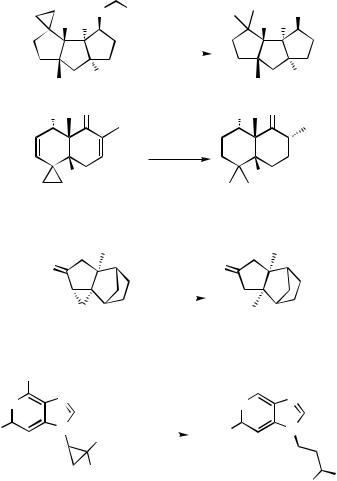
998 |
III Pd-CATALYZED CROSS-COUPLING |
O |
Ph |
|
H H |
|
2 atm H2 |
|
|
Pd/C, Pt |
|
|
AcOH |
H
20
EtO O
H2 Pd/CaCO3, Pt
AcOEt, AcOH r.t.
OH
H H
H
21
EtO O
|
|
|
H |
|
|
|
|
|
|
|
H |
|
|
|
|
|
|
O |
|
|
|
|
|
O |
|||||
|
|
|
22 |
|
|
|
|
|
|
23 |
|
|
|
|
|
|
|
|
|
|
|
Scheme 6 |
|
|
|
|
|
||
|
|
|
O |
2.7 atm H2 |
O |
|
|
|
||||||
|
|
|
Pd/C (10%) |
|
|
|
||||||||
|
|
|
|
|
|
|
EtOH |
|
|
|
|
|
||
|
|
|
|
|
|
|
r.t., 6 h |
|
|
|
|
|
||
|
|
|
24 |
|
|
|
|
25 |
100% |
|||||
|
|
|
|
|
|
|
Scheme 7 |
|
|
|
|
|
||
|
|
|
Cl |
|
|
|
|
|
|
|
|
|||
|
N |
N |
H2 |
N |
|
|
N |
|||||||
|
|
|
|
|
|
|
|
|||||||
|
|
|
|
|
|
|
Pd/C |
|
|
|
|
|
||
H2N |
|
|
N |
|
Et3N |
|
H2N |
|
|
N |
||||
|
|
|
|
CO2Et |
|
|
|
|
|
|
||||
|
|
|
|
|
|
|
|
|
|
|
|
|
||
|
|
|
|
|
CO2Et |
|
|
|
|
|
|
|
CO2Et |
|
|
|
|
|
|
|
|
|
|
|
|
|
|
|
|
|
|
|
26 |
|
|
|
|
|
|
|
27 74% CO2Et |
|||
Scheme 8
Both steric and electronic effects favored the observed ring opening in 28 producing the -methyl aldehyde (Scheme 9).[10] Addition of Et3N helped in suppressing the hydrogenolysis of the benzyl ether functional group.
Inversion of configuration at the tertiary carbon center during the hydrogenolysis of 30 was observed (Scheme 10).[11] This is a normal mode of reaction with Pd catalysts.
In the absence of any electronic activation, whether the C—C bond in the cyclopropyl ring is approachable by the Pd catalyst is probably the key factor in the observed hydrogenolysis of 32 (Scheme 11).[12]
Depending on the substituent R1 in vinylcyclopropane 34, the cyclopropyl ring can open to give methyl or straight chain products (Scheme 12).[13] Methyl products were obtained when R1 was an alkyl group and straight chain products were obtained when R1 was an aryl or acrylate group.
The symmetrical dicyclopropyl 37 hydrogenolyzed to the tetramethylated product 38 in 88% yield.

O OMe
O
O
O
H O
Ph
28
O
30
H
OCH2Ph
H CO2Me
32
atm H2 Pd/C (10%)
|
CO2Et |
EtOH |
|
|
R1 |
|
r.t., 48 h |
R1 |
|
|
R2 |
|
|
|
|
34 |
|
|
|
R1 = i-Pr, R2 = H |
90% |
|
||
R1 |
= cyclohexyl, R2 = H |
94% |
|
|
R1 |
= cyclohexyl, R2 = Me 96% |
|
||
CO2Et
EtOCO
Me
Me
37
III.3.1 Pd-CATALYZED HYDROGENOLYSIS |
999 |
50 psi H2 |
O |
|
|
Pd/C (10%) |
O |
MeOH, Et3N |
 O OMe
O OMe
O
H O
Ph
29 65%
Scheme 9
3.3 atm H2 |
O |
70 wt % of Pd/C (10%) EtOH
r.t., 0.3 h
H  31 89%
31 89%
Scheme 10
|
H |
3.4 atm H2 |
OH |
11 wt % of |
|
Pd/C (10%) MeOH, r.t., 24 h
H CO2Me
33 85%
Scheme 11
|
|
|
|
|
R2 |
|
|
CO2Et |
+ R1 |
|
CO2Et |
|
|
|
|
||
|
R2 |
|
|
|
|
35 |
|
|
36 |
|
|
|
R1 |
= Ph, R2 = H |
|
82% |
|
|
R1 |
= Ph, R2 = Me |
|
80% |
|
|
R1 |
= (E)-EtOCOCHCH, R2 = H |
90% |
||
|
|
|
|
|
CO2Et |
|
|
EtOCO |
Me |
|
Me |
|
|
|
|
||
|
|
|
|
|
|
|
|
|
38 |
88% |
|
Scheme 12
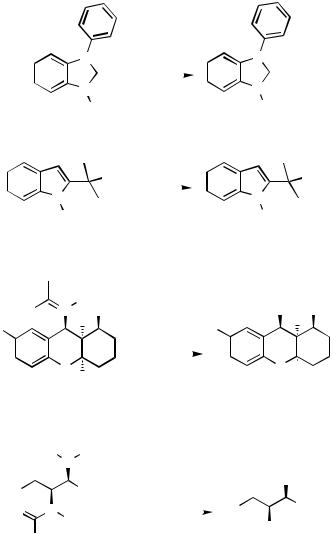
1000 |
III Pd-CATALYZED CROSS-COUPLING |
C. HYDROGENOLYSIS OF N—O BOND
The N—O bond can be hydrogenolyzed under mild reaction conditions, generally in a protic solvent with Pd catalyst and H2. The N-methoxy group in imidazolone 39 was cleaved in excellent yield (Scheme 13).[14]
N-Alkoxy indoles were hydrogenolyzed to indoles (Scheme 14).[15]
Both primary and secondary amines can be obtained from the hydrogenation of nitrones (Scheme 15).[16]
Hydroxylamines derived from the Grignard addition to nitrones were hydrogenolyzed to give primary amines after the N-benzyl group on the nitrogen was simultaneously hydrogenolyzed (Scheme 16).[17]
|
|
|
|
|
N |
||
|
|
|
|
|
|
|
O |
|
|
|
|
|
|
|
|
|
|
|
|
|
|
|
|
|
|
|
|
|
N |
||
|
|
|
|
39 |
OMe |
||
|
|
|
|
N |
|
OH |
|
|
|
|
|
||||
|
|
|
|
|
|
|
|
|
|
|
|
|
|
|
|
|
|
|
|
OMe |
|||
41 |
|
|
|
||||
|
|
Ph |
+ |
O− |
|||
|
|
N |
OH |
||||
F |
|
H |
|||||
|
|
|
|
||||
|
|
|
|
O |
H |
||
|
|
|
|
||||
|
|
|
|
||||
|
|
|
|
43 |
|||
|
|
|
|
|
|
|
|
|
|
|
HO |
CH2Ph |
|||
|
|
|
|
N |
|
|
|
Ph |
|
Me |
|||||
|
O |
N |
|
|
|
||
|
|
|
|
CH2Ph |
|||
PhCH2O |
45 |
|
|
|
|||
|
3.4 atm H2 |
|
|
|
||||||
|
Pd/C |
N |
||||||||
|
EtOH, r.t. |
|
|
|
|
O |
||||
|
|
|
||||||||
|
|
|
|
|
|
|
|
|
|
|
|
|
|
|
|
|
|
|
|
|
|
|
|
|
|
|
|
|
|
N |
||
40 81% |
H |
|||||||||
|
Scheme 13 |
|
|
|
||||||
|
H2, Pd/C |
|
|
|
||||||
|
MeOH, r.t. |
|
|
|
|
|
|
OH |
||
|
|
|||||||||
|
|
|
|
|
|
|
|
|
|
|
N
H 42 85%
Scheme 14
atm H2 |
|
H2N OH |
|
38 wt % of |
|
||
Pd/C (10%) |
|
H |
|
F |
|||
AcOH |
|||
r.t., 24 h |
|
|
|
O  H
H
44 86%
Scheme 15
4.8 atm H2 |
|
NH2 |
|
3 wt % of |
|
||
Pd(OH)2/C(20%) |
|
|
|
MeOH, 72 h |
Ph |
Me |
|
|
|
||
NH2
46 86%
Scheme 16
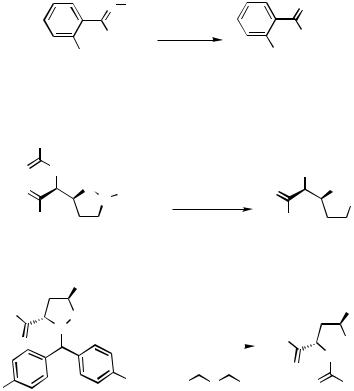
III.3.1 Pd-CATALYZED HYDROGENOLYSIS |
1001 |
Amidoxime 47 was reduced to amidine 48 in 94% yield (Scheme 17).[18] Use of TFA/TFAA instead of AcOH/Ac2O was better in one instance.
Ring opening of cyclic compounds containing an N—O bond is readily accomplished to give amino alcohols. For isoxazolidines 49 and 51 the O-benzyl, N-benzyl, and N- benzhydryl groups were also cleaved under the reaction conditions (Scheme 18).[19],[20]
With isoxazolones 53 and isoxazolidinones 55, -amino acids were obtained (Scheme 19).[21],[22] Spontaneous decarboxylation was only observed with substitution on C-3 of the isoxazolone ring (54b). In these examples, the olefin and the N-p-methoxybenzyl groups stayed intact.
Instead of alcoholic solvents, THF has also been used for the hydrogenolysis of the N—O bond as in isoxazolidine 57 (Scheme 20).[23]
The rate of hydrogenation of O-methyloxime was slower than the hydrogenolysis of benzyloxycarbonyl and N—O groups in 1,2-oxazine 59, which allowed the subsequent reductive amination to take place providing piperidine 60 (Scheme 21).[24]
The use of Lindlar’s catalyst and aqueous acidic conditions allowed the generation of -hydroxy ketone 62 from oxazole 61 with the disubstituted olefin remaining intact (Scheme 22).[25] A yield of 65% was obtained even when a monosubstituted olefin was present.
atm H2, N OH Pd/C
AcOH, Ac2O
r.t., 2−4 h
NH2 OMe
47
Scheme 17
PhCH2O |
|
|
O |
N |
|
O |
O |
CH2Ph |
|
N |
|
PhCH2O |
|
|
49 |
|
|
|
CO2Bu-t |
|
3.4 atm H2
125 wt % of Pd(OH)2/C(20%) EtOH, 6N HCl r.t., 72 h
NH
NH2
OMe
48 94%
NH2 |
|
O |
OH |
|
NH2 |
OH |
|
50 |
85% |
EtO |
O |
|
H2 |
|
|
|
|
|
CO2Bu-t |
||
|
N |
|
Pd/C(10%) |
EtO |
|
||||||
|
O |
|
MeOH |
|
|
|
|
OH |
|||
|
|
|
|
|
|
|
|
|
|
||
|
|
|
O |
O |
O |
NH |
|||||
|
OMe |
|
|
|
|
|
|
|
|
|
|
MeO |
t-BuO O |
|
|
OBu-t |
O |
OBu-t |
|||||
|
|
|
|
|
|
|
|
|
|
|
|
|
51 |
|
|
|
|
|
|
|
|
52 |
82% |
|
|
Scheme 18 |
|
|
|
|
|
|
|||
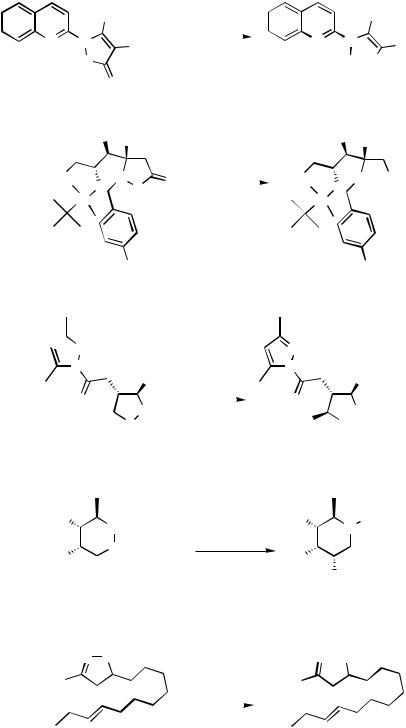
1002 |
III Pd-CATALYZED CROSS-COUPLING |
|
|
|
|
R |
atm H2 |
|
R |
|
Pd/C(10%) |
|
||
|
|
|||
|
|
EtOH, 2 h |
|
|
|
|
|
|
|
N |
N |
CO2Et |
|
N |
N |
CO2Et |
|
O |
|
|
H R1 |
||
53 |
|
54 95% |
|
|||
O
54a R = H, R1 = CO2H 95%
54b R = Me, R1 = H 100%
AcO |
H |
|
|
|
|
|
|
AcO |
N |
O |
O |
O |
|
|
|
Si |
|
|
|
H2 |
|
AcO |
H |
Pd/C(10%) |
|
|
|
MeOH |
|
|
|
r.t., 0.5 h |
AcO |
O |
NH CO2H |
|
|
|
Si
55 |
OMe |
56 |
|
OMe |
Scheme 19
 N
N
N
O
Ph
57
HO
N
O
HO
59
N
N O
n-C5H11
61
Ph
N Ph
Ph
O
 CO2CH2Ph
CO2CH2Ph

 OMe
OMe
atm H2 |
N |
|
|
22 wt % of |
N |
|
|
Pd/C (5%) |
Ph |
||
THF |
|
||
r.t., 24 h |
O |
|
|
|
|
NHPh |
|
|
|
Ph |
|
|
|
OH |
|
|
|
|
|
|
|
58 |
98% |
Scheme 20 |
|
|
|
H2 |
|
|
|
16 wt % of |
|
|
|
Pd/C (5%) |
HO |
H |
|
H2O |
|
N |
|
r.t. −50 °C, 38 h |
|
|
|
HO
72%
60 OH
Scheme 21
atm H2 |
|
|
|
335 wt % of |
O |
OH |
|
Lindlar,s cat. |
|||
MeOH/H2O |
n-C5H11 |
|
|
AcOH |
|
||
r.t., 36 h |
|
|
|
|
|
62 |
84% |
Scheme 22 |
|
|
|
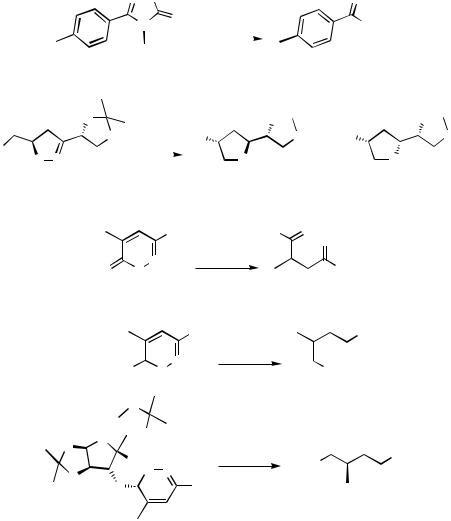
III.3.1 Pd-CATALYZED HYDROGENOLYSIS |
1003 |
Hydrogenolysis of oxazolidinone 63 gave amidine 64 in excellent yield (Scheme 23).[26] Primary chloride removal was also slower than N—O bond cleavage. Thus, the newly formed amine from the highly diastereoselective reduction of oxazole 65 was able to further react with the chloro electrophile producing the pyrrole in an overall 96% yield
(Scheme 24).[27]
The catalytic reduction proceeded first with the N—O bond cleavage but the sequence of subsequent chemical transformations has not been delineated. Since ketone can be generated from the hydrogenation of oxazine 68[28] (Scheme 25), there is a possibility that reduction of the cyclic imine is the final step of the sequence.
1,4-Reductive nitrogen transposition could be carried out with dihydrooxazine 70. A diastereoselective version, in which the diacetoneglucose was used as an auxiliary, provided chiral 73 in 80% ee (Scheme 26).[29]
N |
|
O |
|
H2 |
NH |
|
|
|
|||||
|
|
|
O |
Pd/C |
|
|
|
N |
EtOAc/AcOH |
NHMe |
|||
|
|
r.t., 20 h |
|
|||
63 |
|
|
|
64 |
99% |
|
|
|
|
|
Scheme 23 |
|
|
O |
H2 |
|
Pd/C |
||
|
||
O |
MeOH |
|
Cl |
r.t., 18 h |
O N 65
Ph
N
O O
68
N
MeO 70 O
O
O  O
O
O
H O N
O
O
72
O O
O
HO |
O |
HO |
|
|
+ |
NH |
66 91.2% |
|
Scheme 24 |
|
|
atm H2
53 wt % of HO Pd/C (10%) AcOH, 24 h
Scheme 25
Ph
H2, Pd/C
MeOH, r.t.
O
O
Ph
69 59%
NH2
O
NH 67 4.8%
Ph
71 74%
H2, Pd/C
MeOH, r.t. Ph
H2N
Ph
68%
73 80% ee
Scheme 26

1004 III Pd-CATALYZED CROSS-COUPLING
With suitably constructed oxazapyrrolidinones, new heterocycles can also be formed via the hydrogenolysis of the N—O bond followed by a reclosure sequence. The formation of pyrazinone 75 from isoxazolone 74[30], indole 77 from oxadiazole 76,[31] and imidazole 79 from isoxazolone 78[32] have been reported (Scheme 27).
Subjecting alkyl nitrates to hydrogenolysis conditions gave alcohols (Scheme 28).[33] Transfer hydrogenolysis using ammonium formate has also been used for
N—O cleavage at 60 °C to give -acylaniline 83 from benzisoxazole 82 in 66% yield (Scheme 29).[34]
O H 
N N
N Ph
Ph
O
O
O Ph
74
N
O
|
N |
NH2 |
|
76 |
Ph |
|
N |
|
N |
N |
O |
O |
|
78 |
|
atm H2
18 wt % of Lindlar,s catalyst EtOH
r.t., 10 h
H2
10 wt % of Pd/C (8%) EtOH, r.t.
1. H2
25 wt % of Pd/C (10%) AcOEt
r.t., 0.5 h
2. HBr, AcOH
−CO2
−HNMe2
Scheme 27
Ph H
N  O
O
N |
Ph |
75 |
95% |

 NH
NH
 NH
NH
 Ph
Ph
77 71% O
N NH
NH
79 90−95%
TBDMSO |
|
H2 |
H H |
NO2 |
|
|
Pd/C |
|
|
O |
EtOAc |
N |
O |
0.5 h |
|
||
O |
Si |
|
t-Bu |
Bu-t |
|
80 |
|
|

 N
N
|
O |
|
N |
82 |
N |
|
Scheme 28
HCO2NH4 30 wt % of Pd/C (10%)
MeOH, 60 °C
Scheme 29
TBDMSO
H H |
|
|
|
OH |
|
N |
O |
|
O |
Si |
|
Bu-t |
||
t-Bu |
||
81 |
100% |

 NH2
NH2

 O
O
N 
N
83 66%
